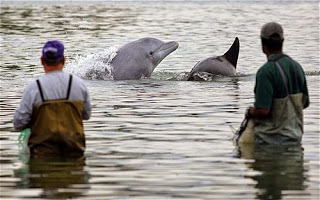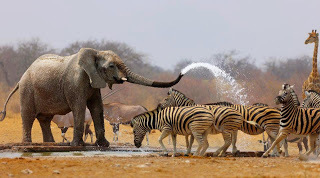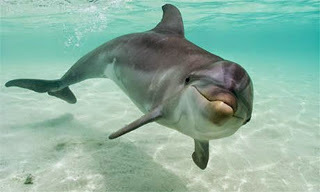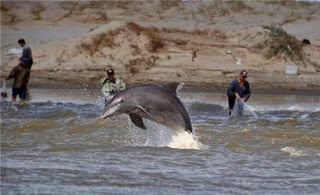Nature Cooperating & Laguna’s Bottlenose Dolphins
 Dolphins helping fishermen catch mulletA few posts back, I discussed the phenomenon called “endosymbiosis” by Dr. Lynn Margulis, who posited a cellular evolution based on ‘cooperation’ rather than simple ‘competition’ between viral or bacterial infection and host cell. This co-evolutionary behaviour runs counter to the traditional route of natural selection and contradicts the ruthless selfishness of Neo-Darwinian thinking. Such an evolving relationship between two different species of life, living together in a very close affinity of mutual benefit is, in fact, common in nature.Co-evolution (and cooperation by default) is now an established theme in the biology of virus-host relationships. Relationships span from the complex interaction between arboviruses and their vector mosquitoes to the one between the malaria-causing plasmodium and humans or the hantavirus and the deer mouse. Virologist, Frank Ryan states that “today...every monkey, baboon, chimpanzee and gorilla is carrying at least ten different species of symbiotic viruses.”
Dolphins helping fishermen catch mulletA few posts back, I discussed the phenomenon called “endosymbiosis” by Dr. Lynn Margulis, who posited a cellular evolution based on ‘cooperation’ rather than simple ‘competition’ between viral or bacterial infection and host cell. This co-evolutionary behaviour runs counter to the traditional route of natural selection and contradicts the ruthless selfishness of Neo-Darwinian thinking. Such an evolving relationship between two different species of life, living together in a very close affinity of mutual benefit is, in fact, common in nature.Co-evolution (and cooperation by default) is now an established theme in the biology of virus-host relationships. Relationships span from the complex interaction between arboviruses and their vector mosquitoes to the one between the malaria-causing plasmodium and humans or the hantavirus and the deer mouse. Virologist, Frank Ryan states that “today...every monkey, baboon, chimpanzee and gorilla is carrying at least ten different species of symbiotic viruses.”Russian biologists, Andrei Famintsyn and Konstantine Merezhkovskii invented the term “symbiogenesis” to explain the fantastic synthesis of new living organisms from symbiotic unions. Citing the evolution of mitochondria and the chloroplast within a primitive host cell to form the more complex eukaryotic cell (as originally theorized by Lynn Margulis), Ryan noted that, “it would be hard to imagine how the step by step gradualism of natural selection could have resulted in this brazenly passionate intercourse of life!” A new science is emerging that recognizes a far more intelligent (and cooperative means) evolution, aptly described by Margulis, "through the long-lasting intimacy of strangers." The fusion of symbiosis followed by natural selection leads to increasingly complex levels of individuality, Margulis suggested. She contended that evolution proceeds through cooperation, not competition: "Life did not take over the globe by combat, but by
 networking."
networking."Examples of such networking, including interspecies cooperation, mutualism and altruism abound in Nature.In Africa birds called ox-peckers perch on the backs of large animals such as giraffes and cattle, and remove insects. The ox-peckers also warn of approaching danger through their cries and disturbed flight. Defenseless fish live unharmed amid the stinging tentacles of jellyfish, and birds such as the wheatear may nest in rabbit burrows. Many flowering plants are pollinated by insects, flitting from flower to flower for their nectar. Some flowers are shaped to suit a particular insect. Seeds are distributed by animals. Birds eat fleshy seeds and transport them. The burrs on plants such as burdock have hooks that may catch on to fur and feathers.
 Enter the dolphin… Perhaps one of the best examples of interspecies cooperation (or mutualism and altruism). In 2008 Aubrey Manning (Emeritus Professor of Natural History at Edinburgh University) wrote in the Daily Mail of a female dolphin who selflessly saved a beached mother whale and her calf off Mahia Beach in New Zealand. The bottlenose dolphins off Laguna in Brazil have developed a cooperative relationship with the local fishermen… "Through highly synchronized behavior with humans, cooperative dolphins in Laguna drive mullet schools towards a line of fishermen and 'signal,' via stereotyped head slaps or tail slaps, when and where fishermen should throw their nets," wrote lead author Fabio Daura-Jorge of the Federal University of Santa Catarina. The cooperation is helpful to both parties, he said.New research has found that one local group of about 20 dolphins works with the fishermen, while other local dolphins don't cooperate, finding other sources of food. A study published in the latest Royal Society Biology Letters found that the most helpful ones are also particularly cooperative and social with each other.
Enter the dolphin… Perhaps one of the best examples of interspecies cooperation (or mutualism and altruism). In 2008 Aubrey Manning (Emeritus Professor of Natural History at Edinburgh University) wrote in the Daily Mail of a female dolphin who selflessly saved a beached mother whale and her calf off Mahia Beach in New Zealand. The bottlenose dolphins off Laguna in Brazil have developed a cooperative relationship with the local fishermen… "Through highly synchronized behavior with humans, cooperative dolphins in Laguna drive mullet schools towards a line of fishermen and 'signal,' via stereotyped head slaps or tail slaps, when and where fishermen should throw their nets," wrote lead author Fabio Daura-Jorge of the Federal University of Santa Catarina. The cooperation is helpful to both parties, he said.New research has found that one local group of about 20 dolphins works with the fishermen, while other local dolphins don't cooperate, finding other sources of food. A study published in the latest Royal Society Biology Letters found that the most helpful ones are also particularly cooperative and social with each other.
 Dolphins help fishermen catch mulletAbout 200 local artisanal fishermen are almost entirely reliant on the dolphins for catching their fish," Daura-Jorge wrote. The fishermen only fish with the assistance of cooperative dolphins, recognized and named.
Dolphins help fishermen catch mulletAbout 200 local artisanal fishermen are almost entirely reliant on the dolphins for catching their fish," Daura-Jorge wrote. The fishermen only fish with the assistance of cooperative dolphins, recognized and named. The cooperation behavior may be passed down from mother dolphin to her calves through social learning, reflecting how the trait is passed down by the fishermen: Elders in the community teach the younger fishermen how to work with the dolphins.
 We tend to exclude the rest of animal and plant life from exhibiting the highest form of intelligence: that of cooperation and altruism. Many of us—if we even accept the existence of true altruism—consider it an exclusively human quality. This is a hubristic remnant of a “conquest” mentality in which humanity identifies itself as separate from Nature. It blinds us from a reality that lies right before us. We cannot see what we don’t look for; we can’t know what we don’t believe.
We tend to exclude the rest of animal and plant life from exhibiting the highest form of intelligence: that of cooperation and altruism. Many of us—if we even accept the existence of true altruism—consider it an exclusively human quality. This is a hubristic remnant of a “conquest” mentality in which humanity identifies itself as separate from Nature. It blinds us from a reality that lies right before us. We cannot see what we don’t look for; we can’t know what we don’t believe. We rely on science to answer questions we already “know” the answers to, because we have lost a sense of Unity. And as Goethe said of conventional scientists, “Whatever you cannot calculate, you do not think is real.”
Richard Tarnas, author of The Passion of the Western Mind posits that the evolution of the Western mind has been driven by a “heroic impulse to forge an autonomous rational human self—a transforming self—by separating it from the primordial unity with nature.” Tarnas suggests that it began four millennia ago, with the great patriarchal nomadic conquests in the Mediterranean. Conquests that embraced “the repression of undifferentiated unitary consciousness and the participation mystique with nature; a denial of the anima mundi, of the soul of the world, of the community of being, of the all-pervading, of mystery and ambiguity, of imagination, emotion, instinct, body, nature, woman.”Goethe and others like him believed that the human mind is ultimately the organ of the world’s own process of self-revelation. In this view, Nature is not a separate, independent self-contained reality to be ‘objectively’ examined by humanity from without; rather, its unfolding truth emerges only with the active participation of the human mind. It is something that comes into being through the very act of human cognition.
Related Posts:Co-evolution: cooperation & aggressive symbiosisWhat Altruism in Animals can Teach Us About OurselvesMargaret Atwood’s Wise Words About Debt & Altruism…”A Portrait of the Artist as a Real Hero”Is James Bond an Altruist?Gaia vs. Medea: A Case for AltruismRupert Sheldrake and the Physics of AngelsThe Gaia HypothesisSpiritual Ecology and the Lesson of Crete
Choosing the Less Worn Path of Intuition
Published on May 10, 2015 21:23
No comments have been added yet.



